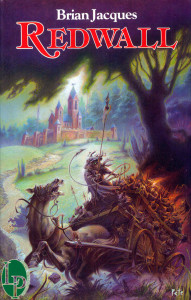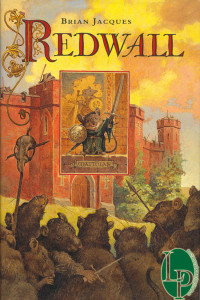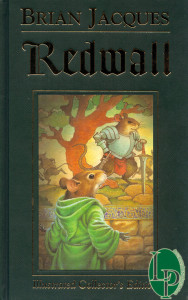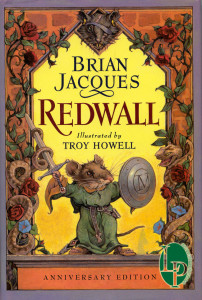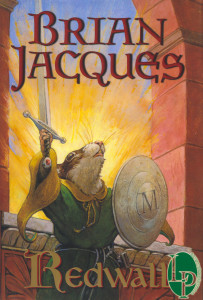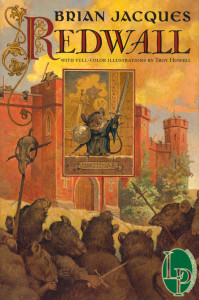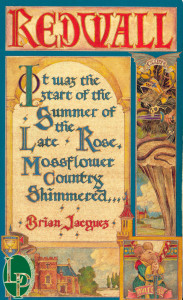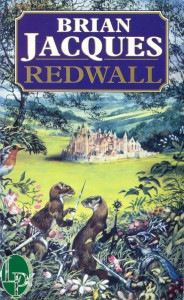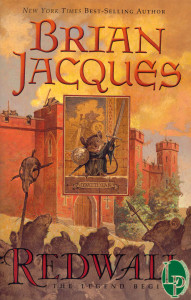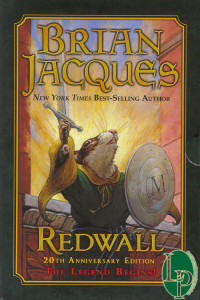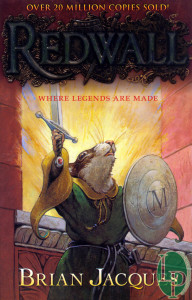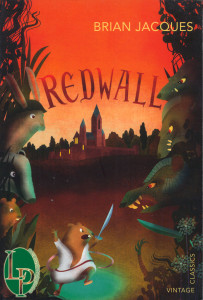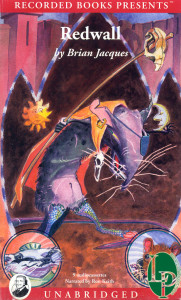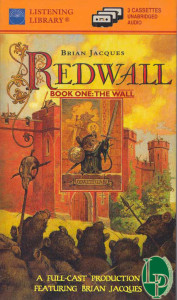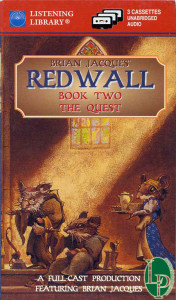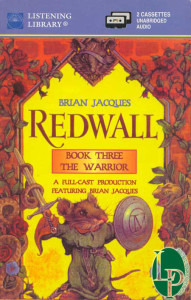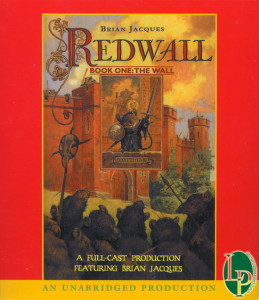As the book that started it all, Redwall has spawned many different editions and reissues, far more than any other novel written by Brian Jacques. Certainly time is a contributing factor— more time since its original publication in 1986 means it’s simply had more opportunity to be reissued than the other volumes. But there’s a qualitative element, as well, as Redwall is arguably the most timeless tale. The young novice of Redwall Abbey must find his courage, solve ancient riddles, recover a lost heirloom, and defend his adopted home (and the mousemaid he fancies) from a perilous rat and his vermin horde. A youngster is forced to grow up, deal with the loss of his mentor, and step into the role fate has ordained for him. What’s not to love?
Redwall is, without a doubt, the largest segment of my collection. Not even counting adaptations like the television series or the graphic novel (which I consider to be distinct and separate products), I own 20 different editions of the book (and that counts the unabridged audio book, whose cassette release broke it into three separate products, as a single edition). That will make this the longest entry in my collection, but also the perfect way to kick off this feature. So, let’s run through them all.
Hardcovers
First and foremost is the foundation of any collection, the source of everything that followed, the original UK hardcover. More specifically, this is a 1st edition/1st printing 1986 UK hardcover. The book is not particularly hard to find, but finding one in decent condition at a reasonable price does take some searching. I procured my copy several years prior to Brian’s passing and prices have definitely increased since then, but I was quite pleased to find my copy (tight binding, unclipped, minimal shelf wear) for less than $50. Collectable aspects aside, the book features a distinctive cover by Pete Lyon that was one of the first I ever saw (in the form of a small GIF on David Lindsey’s book review on the Official Redwall Abbey Homepage in 1996). With Redwall Abbey featured serenely in the background, an exhausted horse bucks as it pulls a flame lit cart teeming with rats, the meanest and largest of them all whipping the horse into a frenzy. On the back cover, young Matthias dressed in a green habit peeks out between stalks of grain.
Inside the cover flap, the description of the book barely takes up 1/3 of the available space. It closes with, “Brian Jacques is an outstanding new British author, who has produced a classic book in the grand tradition of Duncton Wood, The Hobbit, and Watership Down.” As the debut volume, there is obviously no “Also by Brian Jacques” page, just the Gary Chalk map and the start of the tale. The back flap does not even feature Brian’s picture, just a short biography that emphasizes his radio show Jakestown and his contributions to the Everyman Theatre. It’s an interesting look at the genesis of the series, where the publisher was still obviously trying to figure out what they had in Brian and how to effectively market the book. It’s made all the more remarkable when contrasted to later volumes, where Brian’s name and photograph became major marketing elements.
This was followed in 1987 with the release of the original US hardcover, which in addition to being larger than the UK hardcover, replaced Lyon’s cover with one by Troy Howell. For my money, this is by far the best, most iconic cover that Redwall has ever had. It will be reused (and replaced) many times over, but is just a joy to look at. With Redwall Abbey flanked by golden hued clouds, a rat army with weapons drawn at their gate, in the center stands brave young Matthias, sword raised, ready to defend his home. On the back cover is one of the most frightening images of Cluny the Scourge ever produced. The interior is roughly the same as the UK edition, although the book flaps are better constructed.
This copy was a gift from my mother the very first Christmas after I started reading the series. This was a time at the height of Redwall’s popularity, when hardcover editions of the books could still be found in bookstores. To make this copy extra special, though, it was one of the ones I carried with me to the Brian Jacques book signing I attended in 1997. It’s signed by Brian Jacques and personalized to me. Utterly irreplaceable.
The year 1997 brought with it a celebration of the series and a pair of special commemorative editions. The first of these was the UK Illustrated Collector’s Edition which retained all of Gary Chalk’s chapter illustrations, but not his map. It boasted a new cover drawn by Chris “Fangorn” Baker (who by that point was the standard UK cover artist). Baker also drew 13 full color illustrations which were sprinkled throughout the book as color plates— Mortimer standing over Matthias; Cluny addressing his horde; Matthias in front of the tapestry of Martin the Warrior (also the cover); Matthias meeting Basil Stag Hare; Cluny crossing the plank; Matthias and Methuselah discovering Martin’s tomb; Matthias and Methuselah reviewing the archives; Matthias in the midst of the sparra; Friar Hugo cradling Methuselah’s body as Chickenhound looks on; Cluny’s army attacking Redwall’s gates; Matthias meeting the GUOSIM; Matthias facing Asmodeus; and a fully armored Matthias battling Cluny the Scourge.
Unlike other hardcover editions, the Illustrated Collector’s Edition does not have a dust jacket. The cover is green cloth with gold embossed lettering— in the center is one of Fangorn’s color plates, of Matthias standing before the tapestry of Martin. A green ribbon bookmark is attached to the spine of the book. In addition to the new color plates, a full color map drawn by Fangorn is printed in both the front and back of the book. Finally, there is a full page introduction written by Brian Jacques, where he reflects on the success of the series. He also notes that, “Ten years equals forty seasons in Redwall time…” All told, it’s a fantastic edition of the book that remains one of my favorites. Part of its attractiveness is that you get all of Gary Chalk’s original chapter illustrations in addition to the new color plates by Fangorn. With 13 color plates, it does not disappoint.
The second commemorative edition released in 1997 is the US 10th Anniversary Edition (although it technically is simply titled the “Anniversary Edition”). Here the US’ year delay in releasing Redwall allows it to bill its release as a true anniversary, rather than simply a collector’s edition. Troy Howell is given the opportunity to revisit a book he’s already drawn one cover for and he delivers another outstanding piece. With Matthias in the same heroic pose as the original, this time he’s flanked by rose-covered red bricks, through which Asmodeus weaves. Cluny’s head tops the piece. On the back, Redwall Abbey sits framed by forest growth, in which rests Silent Sam, Captain Snow, two rats, and a fox.
Inside the volume, the publisher proclaims, “It is a great privilege for the Publisher to create this exquisitely illustrated anniversary volume, celebrating the distinguished work of Brian Jacques.” Brian again gives a full page introduction to the text, reflecting on the origins of the series. The real change in this edition comes from the fact that it completely drops all of Gary Chalk’s original illustrations, each chapter only being adorned by its number. Troy Howell illustrates a completely new black and white map and a black and white heading for the three books of Redwall (The Wall, The Quest, & The Warrior). The centerpiece, though, is five color plate illustrations throughout the book: Matthias falling from the rooftop with King Bull Sparra; Cluny addressing his horde; Constance rallying wallop defenders; Matthias, Methuselah, and Cornflower considering the tapestry riddle; and Basil Stag Hare (flanked by Jess Squirrel) bowing. Each is phenomenally illustrated. Interestingly, a sixth color plate was illustrated of Matthias crossing the river as the GUOSIM look on, but was not included in this edition. It would first be used on the spine of an audio book, before finally seeing publication in a later edition which I will cover shortly.
The next hardcover release came in the early 2000′s, when the official Redwall La Dita Bookshop struck a deal with UK publisher Hutchinson to reissue the original UK hardcover in a new Author’s Limited Edition release. Limited to only 500 copies, La Dita exhausted their stock within a few years and it’s incredibly difficult to track down a copy these days. In terms of the volume itself, it is very close to the original UK release. The cover is the same Cluny-and-his-cart artwork created by Pete Lyon. There is no outward indication that it is actually a distinct edition of the book. The text on the cover flaps is longer and more detailed, with the story description taking up the entire front flap this time and the author biography referencing his later volumes like Mossflower, Mattimeo, and Salamandastron. Unlike the original release, there is an “Also by Brian Jacques” page which lists all of Brian’s works published by Random House/Hutchison (Redwall through The Taggerung), including companions like The Tribes of Redwall: Mice.
The story itself is virtually unchanged, with all of Gary Chalk’s chapter illustrations and his map present. In short, the only thing that sets this edition apart is the fact that the title page actually says:
Author’s limited edition
Edition number ### of 500
The actual edition number is hand-written. Below this is Brian’s autograph, making it the second autographed edition of Redwall in my collection. With only a single page to really identify it, the Author’s Limited Edition is fairly unique. Certainly one of the most collectable of editions.
The sixth and final hardcover edition in my collection is the US 20th Anniversary Edition from 2007, although the release itself isn’t titled that. After all the pomp and circumstance surrounding the Illustrated Collector’s Edition and the 10th Anniversary Edition, expectations were high for another anniversary edition bringing new color plates and other goodies with it. Troy Howell drew an unprecedented (and phenomenal) third cover for the book, again with Matthias in a heroic pose, this time in front of a Redwall window and flanked by the rising sun. The release looked very attractive. Inside, though, it was essentially what was released in 1987. There is no introduction by Brian Jacques, all of Gary Chalk’s chapter illustrations (and map) are present, while none of Troy Howell’s illustrations are. There is nothing to indicate that this is an anniversary edition at all, other than the new cover art. I should point out that, prior to its release, online retailers did display the cover art with a silver sticker proclaiming it the “20th Anniversary Edition.” Beyond those online retailers, though, I’ve not seen any indication that that particular iteration of the cover was ever actually released. It seems to have simply been a marketing image. All that said, as a collector, it’s still a great edition to have and probably one of the easier ones to find these days. It’s also the first hardcover release of Redwall to feature a full-sized portrait of Brian Jacques on the back cover rather than artwork. (Actually, it’s the only Redwall hardcover in my collection that has a picture of Brian at all).
Trade Paperback
This will be a short section, as there is only a single entry, but it’s a distinctive enough entry that it warrants special attention: the US Trade Paperback Edition from 2000. For those that don’t know, a trade paperback is a paperback book that is roughly the same size as a hardcover book (as opposed to mass-market paperbacks, which are pocket sized). To my knowledge, this edition was the only commercially released trade paperback edition of any book in the Redwall Series. It features Troy Howell’s original cover art, although Brian’s name is featured more prominently and it also notes that there are color illustrations by Troy Howell inside. The back cover drops the artwork of Cluny in favor of review quotes praising the novel.
Inside, the edition matches the 10th Anniversary Edition. It includes Brian’s full page introduction (although not the message from the publisher). It does not include any of Gary Chalk’s illustrations. Troy Howell’s map and black and white book section illustrations are there. More importantly, so are his color plates. More significantly, the release includes the sixth color plate I mentioned earlier, of Matthias crossing the river while the GUOSIM shrews look on. To date this is the only edition of Redwall that includes this piece of artwork as a full-sized color plate. When I had the opportunity to interview Troy a few years back, I asked him why it wasn’t included in the 10th Anniversary Edition when it was clearly done at that time. Sadly, he didn’t know, as it was the publisher’s decision. Regardless, I was thrilled when it finally saw print in the Trade Paperback Edition and its inclusion makes this a must for a Redwall collection.
Paperbacks
The first paperback edition in my collection is actually the first edition of Redwall I ever read: the US Avon Books Edition, published in 1990. It is perhaps better known as the one with the cover by Thomas Canty. It’s a distinctive cover, notable for an elegant design that blends both the text of the book (“It was the start of the Summer of the Late Rose, Mossflower country shimmered…“) and artwork. It lends the book an air of history, that you are simply reading an obscure tale that sat undiscovered in some dusty old manuscript hidden in a library somewhere.You’ve got the Abbey represented, Matthias, Cluny, all the important elements are there. On the back is the Sword of Martin, framing the description of the book, which concludes with the note that coming soon was a sequel called Mossflower!
For many old school fans of the series like me, this was probably the first edition they read. It was a rare period where the hardcover edition and the paperback edition each got a unique cover. I remember being struck at the time by how distinctive it looked next to the later paperbacks that reused Troy Howell’s hardcover artwork. It succeeded in setting the books apart and I always loved the emphasis Canty’s covers placed on the text passage. Aside from the cover, though, this is a straight-up paperback edition of the book with no added content or special artwork. Gary Chalk’s illustrations are included throughout.
The next edition in my collection is the UK Legend Edition published in 1994, or what I used to term the “Plate Edition” (so named because of the distinctive title-plate the four Legend Editions sported). These covers were relatively obscure in the online fandom until I stumbled upon them in the late-1990s in a UK bookshop’s online catalogue. While only thumbnails at the time, the four editions were beautiful to look at and so I publicized them on my site with a special image update. Of course, as internet booksellers proliferated, the covers became more common (and of better quality) but I always remember the excitement their discovery generated.
John Barber’s artwork perfectly demonstrates the beauty of Mossflower Country and Redwall Abbey, about to be shattered as two armed weasels look on. Almost camouflaged in the foliage (certainly in the early thumbnails) stands Cluny the Scourge in full battle armor. Sadly the artwork does not extend to the back cover, which is instead white with black and red text, the cover nevertheless remains very well done. There are again no surprises inside, it’s the expected book in paperback form with only the cover artwork to really set it apart.
I’m going to discuss the next three editions together, because the differences between them are ultimately minor and are instead more of an illustration of what a collector will buy. Following the publication of the US 10th Anniversary Edition, Ace Books issued a brand new paperback featuring Troy Howell’s 10th Anniversary Edition cover art. In most respects, this is the same book in print today. The first edition is best thought of as the US 10th Anniversary Paperback Edition from 1998. The book frames Howell’s cover art with a purple metallic border, does the same for the back cover art, and features a yellow starburst on the cover proclaiming it as the “10th Anniversary Edition”. The book includes Troy Howell’s map and his three sub-book illustrations, but does not include any of the color plates, nor any of Gary Chalk’s illustrations. Brian’s introduction from the 10th Anniversary Edition is included, however.
The paperback was reissued around 2004, as what I’ll call the US Intermediate Paperback Edition. It still boasted Howell’s 10th Anniversary cover art framed in a light metallic purple, but the starburst on the cover was dropped and it was no longer considered an “Anniversary Edition”. The back cover art was also dropped, replaced with the familiar portrait of Brian Jacques that adorned all later paperbacks. Brian’s introduction from the Anniversary Edition was still included, however, as was Troy Howell’s map and black and white sub-book illustrations. In the back of the book was a text-advertisement for Loamhedge and a black and white reproduction of the cover art for Rakkety Tam (which are useful in dating the release). Once again Gary Chalk’s illustrations are absent.
This progression culminated in the release of the US 20th Anniversary Paperback Edition released in 2008. The 10th Anniversary cover artwork is once again used, it is framed in a darker shade of metallic purple, and now boasts a red starburst on the cover proclaiming it the “20th Anniversary Edition”. Brian’s portrait still graces the back cover. As in the two prior versions, none of Gary Chalk’s illustrations are present, only Troy Howell’s map and three black and white sub-book illustrations. The exact same introduction from the 10th Anniversary Edition is included, right down to Brian’s stating the age of the series as “forty seasons” (i.e. 10 years). An advertisement for Doomwyte is also included in the back. In essence the only thing that makes this edition a 20th Anniversary Edition is the starburst on the cover. For most collectors, getting only one of the last three editions will probably suffice. All three will probably only interest completists like me.
Rewinding the clock, the next edition in my collection is the US Firebird Paperback (#1) Edition. In 2002, presumably in an effort to reach younger readers, Penguin began reissuing the Redwall Series under their Firebird imprint. These books were sized approximately 5″ x 7 3/4″, or roughly halfway between the mass-market paperback editions and the trade paperback editions. Brian’s name was featured more prominently on the cover and, more interestingly, they used Troy Howell’s original cover art for a wide paperback release.
The edition includes all of Gary Chalk’s original illustrations and none of Troy Howell’s anniversary ones. Like the Avon and Legend releases, it’s a standard paperback release of the book. Unlike those releases, though, it (and all of the early Firebird editions) includes a rather neat surprise inside the back cover. The interior side of the back cover includes a page long message from Brian Jacques, different from the introductions he wrote for the earlier commemorative editions. He talks of his love of imaginary worlds, how he thrilled to visit them in his imagination as a young boy, and how Alan Durband was instrumental in getting Redwall published originally. While not earth shattering information to Redwall fans, its inclusion is a nice touch that helps set the early Firebird editions apart.
Firebird followed up by releasing a 20th Anniversary Edition Gift Package in 2007 that remains one of the most impressive Redwall releases I’ve ever seen. I did a full write-up on the release at the time, which you can read here, but to summarize: the box set boasts Troy Howell’s 20th Anniversary Edition cover art. Sliding the package out of its outer shell reveals a cardboard set that’s been treated to look like green leather, with Gary Chalk’s map from the book faux-embossed on the back. Inside are three pouches, inside which rest the three sub-books of Redwall individually bound. Book One: The Wall shows Matthias from Howell’s original cover; Book Two: The Quest shows Redwall Abbey and the invading rats from the same cover; and Book Three: The Warrior shows Cluny the Scourge from the original cover’s back. All three include Gary Chalk’s illustrations, not Troy Howell’s. Brian’s introduction is not present, either. Also included in the set is a stack of 19 Redwall trading cards, Redwall through Eulalia!, but using the Firebird editions’ title dressing with Brian Jacques’ name featured more prominently and titles placed in different positions than the original covers. I emphasize this because these trading cards differ from the regular Redwall trading cards, which instead use the hardcover title dressing (and will be featured in a future write-up). Rounding out the gift package is a small poster featuring Howell’s 20th Anniversary cover on one side and a short biography and portrait of Brian Jacques on the back.
Book Three: The Warrior also includes an article in the back written by Brian’s longtime editor and friend, Patricia Lee Gauch. The 13-page essay is part biography, part reflection, and touches on Brian’s many inspirations for the Redwall Series. As several fans have also noted, Book Three is misidentified as Book Two on one of its three title pages. This has led some to conclude that these “misprint” editions are rare and highly collectible. Unfortunately I’ll have to disagree. What makes something like a misprint or a miscoloration a rare collectible is when the misprint or miscoloration gets corrected in a later, more widely available edition. Until that happens, the misprint is nothing more than what it is: a mistake. Seven years later, I’ve not seen any report or scan where a Gift Package does not contain the Book Two: The Warrior error. Given the many pieces involved in the set— from the three books, 19 trading cards, poster, and collectible box— that’s not surprising. Additional print runs would likely be very expensive for the publisher. Plus, given the temporal dimension to the release— a special 20 year anniversary edition— additional print runs don’t make a lot of sense. Thus, I’m fairly confident the original print run of the set was the only print run of the set. Stores did not stock them heavily (I only found one copy at a local store) and once they sold out, they were gone. Do not misunderstand me, the Gift Package is highly collectible. But only for what it is, not because of a misprint. If someone has encountered a corrected edition, though, I’d love to hear about it. Incidentally, I actually have two copies of this edition: one to open and enjoy, another still sealed in plastic.
My eighth paperback is the US Firebird Paperback (#2) Edition from 2010. With the release of The Sable Quean, the Redwall Series was adorned with a new embossed brand logo that was subsequently added to all of the Firebird book covers. It created a brand identity for the series, tied the books in the series more closely together, and actually looked rather cool. While most books in the series include a short ribbon above Redwall that says “a tale of”, it’s absent from this edition’s title dressing. The cover artwork is once again Troy Howell’s 20th Anniversary cover. The spine of the book also features the new branding, in addition to the depiction of Cluny the Scourge from Howell’s original cover. One of the more interesting additions, however, is that the spine also includes the number “1″. As part of the rebranding effort, the Firebird editions would now be numbered (published order) to further cement their identity as a connected series rather than separate standalone books.
Aside from the new branding and the cover art, the interior of the book is unremarkable. Gary Chalk’s illustrations are included, none of the Anniversary Edition illustrations are present, nor is Brian’s introduction. Disappointingly, the page Brian wrote in the original Firebird Edition was also dropped from this release.
The final paperback in my collection is (as of this writing) the most recent release: 2014′s UK Vintage Children’s Classics Edition. The Vintage Children’s Classics line is billed as a list of classic books that all children should read and I’m thrilled that one of Brian’s books has been recognized. Once again, I’ve done a more detailed write-up on what’s in this edition elsewhere, which you can read here. This is, from the ground up, a new edition in every sense of the word. For starters, it’s got a brand new (and heavily stylized) cover by Dermot Flynn. While the unconventional depictions of woodlanders and vermin hasn’t sat well with some fans, it is definitely atmospheric and helps the book stand out. The book is also incredibly thick, far more so than any of the previous editions I’ve mentioned, clocking in at approximately 550 pages long (counting the appendix, which the edition dubs “The Backstory”). There is no map in this edition and each chapter has a brand new illustration courtesy Rachael Hare.
The text of the story is unchanged and none of Brian’s introductions were recycled. The real additions in this edition come in the afore-mentioned “Backstory,” which starts off with a three-page “Who’s Who?” that provides short descriptions of all the major characters in Redwall. This is followed up by a two-page Redwall quiz, a two-page biography of Brian Jacques, a one-page craft assignment to create your own tapestry, a two-page recipe for baked apples, a two-page glossary of terms, and a page with the answers to the quiz. These sections are fun, interesting, and unique to this edition of Redwall. I’d actually be interested in seeing more Redwall books added to the Vintage Children’s Classics line (such as Mossflower), just to get more “Backstory” sections.
Audio Books
As we enter the home stretch, we’ve reached the final class of editions, the audio books. The first of these is the Ron Keith Edition, which was released by Recorded Books in 1995. There’s no real record of a commercial release of this product, which suggests that it was mainly offered to libraries and other audio book rental locations. I’ve yet to encounter a copy that was not an ex-library copy. The audio book sports an original cover, drawn by Richard Ewing. It features Cluny the Scourge prominently as a purple, thin, hunched over rat. Matthias and Constance are featured in two circles along the bottom. It’s certainly a unique cover and one of the oddest in my collection.
The recording itself is relatively unabridged (the tapestry rhyme and prologue “It was the start of the Summer of the Late Rose…” are absent) with a running time of 13 hours, 15 minutes across 9 cassette tapes (so dig out your Walkman). The book is entirely narrated by Ron Keith, an Englishman with a soothing and strong, clear voice. Keith reads the book rather straight, generally trying to match the mood of the line— wistful for daydreaming and so-on. Some of his woodland characters sound rather similar, although he does attempt to make the villains like Cluny sound distinctive. It’s a fine audio edition of the book, although it pales next to the edition I’ll end with. Read on.
The second audio book is the Stuart Blinder Edition from 2007. I’ve yet to locate any physical copy of this edition, leading me to suspect that one does not actually exist. It was released as a digital audio book downloadable through outlets like Audible and iTunes. Its cover art simply reuses the Blacksheep UK medallion cover art in circulation at the time, a silhouette of Cluny the Scourge backlit by a green glow.
The recording is again unabridged and has a running time of 12 hours, 38 minutes. It is read by a single narrator, Stuart Blinder. Like Keith, Blinder is British and has a generally pleasing voice, although it is higher pitched than Keith’s. The rendition is perfectly acceptable, although like the previous edition pales in comparison to the next one.
In 1997, as part of the 10th anniversary of Redwall in the US, Brian Jacques gathered his family and friends at BBC Radio Merseyside to record an unabridged edition of Redwall with a full cast, including himself. Thus, the Redwall Radio Play Edition was born. With Brian narrating and playing the definitive Foremole, his son Marc took on the role of Matthias and his partner Liz the role of Constance. As anyone lucky enough to hear Brian speak knows, he tells stories with such enthusiasm and charm that it’s impossible not to get drawn in. Backed by a full cast, Redwall was brought to life in a way that had then-been unheard. Due to the length of the unabridged recording, publisher Listening Library decided to break the release into three parts, according to Redwall’s sub-books.
Redwall – Book One: The Wall was released on three audio cassettes with a running time of 3 hours, 5 minutes. The cover art used Troy Howell’s original hardcover, with the spine featuring a close-up of Matthias from the same cover. The front of the box was actually a flap that could be opened up, with the inside revealing the release dates of the second and third volumes, information on the Redwall Reader’s Club, a link to the official Redwall Abbey website (back when it was hosted on David Lindsey’s personal space on Islandnet.com), an offer for a free 17″ x 22″ poster of the cover (which is also in my collection), a breakdown of which chapters are on which cassette side, and a full cast listing. Inside, each cassette was enclosed in a cardboard sleeve that also boasted the same cover art.
Redwall – Book Two: The Quest followed in early 1998, using one of Troy Howell’s 10th Anniversary Edition color plates as its cover art— the one of Matthias, Methuselah, and Cornflower attempting to solve the riddle. On the spine of this release was a small thumbnail of another one of Howell’s color plates, the unprinted one of Matthias crossing the river in front of the GUOSIM. In 1998, this was the first indication that we fans had that this piece of artwork even existed and, as I mentioned earlier, it would not be until the 2000 trade paperback edition that the full illustration finally saw print. In any case, the book was once again spread across three audio cassettes with a running time of 4 hours, 53 minutes. Like Book One, this release also featured a front flap that could be opened to reveal information about promotional offers, Book Three’s release date, the cast information, and so-on. The tapes themselves were once again in cardboard sleeves matching the cover art.
The final release of the trilogy, Redwall – Book Three: The Warrior was released in the spring of 1998. For its cover, Listening Library used Troy Howell’s 10th Anniversary Edition cover set against a brighter yellow background. For its spine another one of Howell’s color plates (Constance rallying Redwall’s defenders) was used. Spread across two cassettes, the recording has a running time of 2 hours, 41 minutes. Once again the cover flap opens to reveal the cast, promotional offers, and more, although it does not tease future releases. Unlike the previous two volumes, Book Three provides its cassettes in standard plastic jewel cases. Because of this, the box is wider than the earlier volumes, causing Book Three to stick out more. This was disappointing to those of us wanting a matching set, but a small annoyance in the end.
This leads me to my final edition of Redwall, the Complete Radio Play Edition. In short, Listening Library reissued the Radio Play as a single release spread across nine CDs, with a running time of 10 hours, 43 minutes. Since I loved the Radio Play so much, I bought it again (the fact that CDs were more versatile than cassettes helped). Curiously, the box art still says “Redwall – Book One: The Wall” despite the fact that the entire production was included. Clearly a case of reusing assets and not checking them closely. Each CD is held in a red cardboard pouch, which reprints the cover artwork. The CDs themselves boast the cover art shaded green with “Redwall – Book One: The Wall” in red letters. Each pouch is labeled with the corresponding disc number.
Having described the Radio Play’s release over four editions thus far, let me talk about the Radio Play itself. The Redwall Radio Play served as the prototype for all fully cast, unabridged audio books to follow. Had it not been such a resounding success— and clearly something Brian enjoyed doing— those subsequent releases would never have happened. As such, its pedigree is substantial. Admittedly, as the first, it’s the most rough around the edges. Billy Maher’s transition music is present, but he had not yet begun turning Brian’s songs and poems into musical numbers, as he would in later volumes.
That said, there is something special about having Brian Jacques himself read and perform his seminal piece of work. Like I said, his joy is infectious and he delivers his lines like no other. At a certain point, you find you can’t hear Redwall tales any other way and I’ve actually found myself reading the books with Brian’s voice— tone, inflection, pronunciation— going through my head. There’s a reason why, out of all the adaptations of Redwall, this one is my favorite. If you have not heard it yet, you’re doing yourself a disservice. Small wonder, then, that no matter how good Ron Keith and Stuart Blinder are, they cannot compare with the author himself and a full cast.
Conclusion
If you’ve made it this far and I’ve held your interest, I thank you. As of this writing, I’ve been a Redwall fan for 18 years and in that time I’ve seen a lot of editions come and go. In that time, while there’s been an awareness of the various editions through cover art, there’s never been a detailed description of what differences (if any) actually distinguish the various editions of the book. I hope you’ve found this essay illuminating in that regard and maybe— just maybe— it’s sparked a collector’s itch you’ll want to scratch in the future. I’d love to hear your thoughts, so swing by The Long Patrol Forums and share them. Thanks for reading! Until next time!
Filed under: Collection, News

